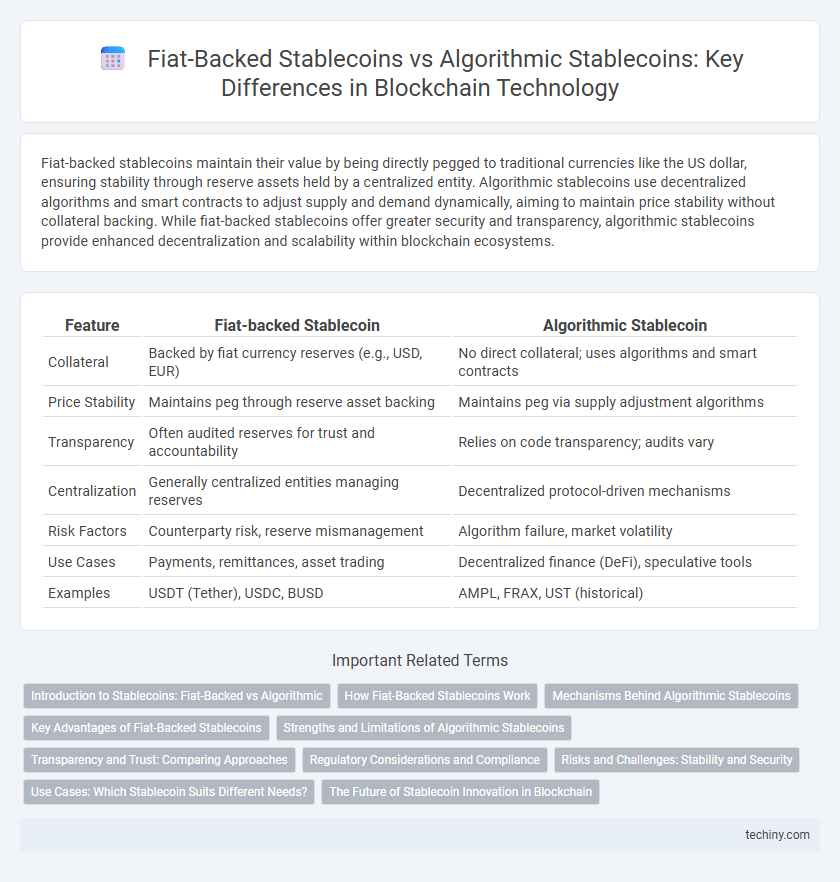Fiat-backed stablecoins maintain their value by being directly pegged to traditional currencies like the US dollar, ensuring stability through reserve assets held by a centralized entity. Algorithmic stablecoins use decentralized algorithms and smart contracts to adjust supply and demand dynamically, aiming to maintain price stability without collateral backing. While fiat-backed stablecoins offer greater security and transparency, algorithmic stablecoins provide enhanced decentralization and scalability within blockchain ecosystems.
Table of Comparison
| Feature | Fiat-backed Stablecoin | Algorithmic Stablecoin |
|---|---|---|
| Collateral | Backed by fiat currency reserves (e.g., USD, EUR) | No direct collateral; uses algorithms and smart contracts |
| Price Stability | Maintains peg through reserve asset backing | Maintains peg via supply adjustment algorithms |
| Transparency | Often audited reserves for trust and accountability | Relies on code transparency; audits vary |
| Centralization | Generally centralized entities managing reserves | Decentralized protocol-driven mechanisms |
| Risk Factors | Counterparty risk, reserve mismanagement | Algorithm failure, market volatility |
| Use Cases | Payments, remittances, asset trading | Decentralized finance (DeFi), speculative tools |
| Examples | USDT (Tether), USDC, BUSD | AMPL, FRAX, UST (historical) |
Introduction to Stablecoins: Fiat-Backed vs Algorithmic
Fiat-backed stablecoins maintain value by being pegged to traditional currencies like the US dollar, ensuring stability through reserves held by centralized entities. Algorithmic stablecoins use complex smart contracts and market mechanisms to adjust supply dynamically, aiming for price stability without direct collateral. Understanding these foundational differences highlights how each approach addresses volatility and trust within the blockchain ecosystem.
How Fiat-Backed Stablecoins Work
Fiat-backed stablecoins maintain a 1:1 peg to a fiat currency by holding an equivalent amount of that currency in reserve, ensuring price stability and reducing volatility. These reserves are regularly audited and can include cash or cash-equivalents, providing transparency and trust for users. By redeeming or issuing coins based on reserve holdings, fiat-backed stablecoins enable seamless value transfer and liquidity within the blockchain ecosystem.
Mechanisms Behind Algorithmic Stablecoins
Algorithmic stablecoins maintain price stability through automated smart contract protocols that adjust the coin's supply based on demand fluctuations, rather than relying on collateral reserves like fiat-backed stablecoins. These mechanisms include seigniorage shares, rebase protocols, and dynamic supply adjustments, which collectively aim to stabilize the coin's value around a target price, typically pegged to a fiat currency such as the US dollar. Unlike fiat-backed stablecoins secured by fiat currency reserves, algorithmic stablecoins use decentralized algorithms and incentives to manage the minting and burning of tokens, minimizing reliance on external assets.
Key Advantages of Fiat-Backed Stablecoins
Fiat-backed stablecoins maintain value stability by being directly collateralized with traditional currencies like the US dollar, offering users assurance through transparent reserves and regulatory oversight. These stablecoins benefit from widespread acceptance and trust due to their linkage with established fiat currencies, making them ideal for everyday transactions and remittances. Their key advantage lies in predictable price stability and liquidity provided by central banks or custodians, reducing volatility compared to algorithmic stablecoins.
Strengths and Limitations of Algorithmic Stablecoins
Algorithmic stablecoins maintain price stability through smart contracts and supply adjustments, eliminating reliance on collateral reserves and enhancing decentralization. Their strengths include censorship resistance, lower collateral requirements, and potential for scalability in decentralized finance applications. However, limitations involve vulnerability to market volatility, risk of depeg events during high demand or sell-offs, and challenges in maintaining long-term stability without sufficient market confidence.
Transparency and Trust: Comparing Approaches
Fiat-backed stablecoins maintain transparency through regular audits and collateral reserves held in traditional financial institutions, fostering trust via tangible assets. Algorithmic stablecoins rely on decentralized protocols and smart contracts to manage supply, offering transparency through open-source code but facing challenges in market confidence during extreme volatility. The differing mechanisms reflect contrasting approaches to trust and transparency, with fiat-backed coins emphasizing asset backing and algorithmic types prioritizing protocol governance.
Regulatory Considerations and Compliance
Fiat-backed stablecoins are subject to strict regulatory scrutiny due to their direct linkage to traditional currencies, requiring compliance with anti-money laundering (AML), know your customer (KYC), and reserve auditing standards imposed by financial authorities. Algorithmic stablecoins face increased regulatory challenges stemming from their reliance on complex mechanisms without physical reserves, raising concerns about transparency, market stability, and consumer protection. Regulatory frameworks continuously evolve to address risks around operational security and systemic impact, emphasizing the necessity for clear compliance protocols in both stablecoin types.
Risks and Challenges: Stability and Security
Fiat-backed stablecoins rely on centralized reserves, posing risks related to regulatory scrutiny, custodial security, and transparent auditing, which can affect stability and trust. Algorithmic stablecoins face challenges in maintaining price stability due to reliance on complex smart contracts and market-driven mechanisms, increasing vulnerability to speculative attacks and protocol failures. Both types encounter security threats from cyberattacks and smart contract bugs, necessitating robust governance frameworks to mitigate systemic risks.
Use Cases: Which Stablecoin Suits Different Needs?
Fiat-backed stablecoins like USDC and Tether provide high stability and regulatory compliance, making them ideal for everyday transactions, remittances, and as a safe haven during market volatility. Algorithmic stablecoins, such as TerraUSD (before its collapse) and Frax, offer decentralized alternatives leveraging complex protocols to maintain price stability without fiat reserves, better suited for decentralized finance (DeFi) applications and yield farming. Choosing between the two depends on the need for transparency, risk tolerance, and the specific DeFi ecosystem integration required.
The Future of Stablecoin Innovation in Blockchain
Fiat-backed stablecoins, anchored by traditional currency reserves like the US dollar, continue to offer stability and regulatory clarity essential for mainstream adoption in blockchain ecosystems. Algorithmic stablecoins leverage smart contracts and autonomous protocols to maintain price stability without centralized collateral, pushing the boundaries of decentralized finance innovation. Future development in stablecoin technology will likely blend regulatory compliance with enhanced algorithmic mechanisms to achieve scalable, secure, and trustless digital currency solutions.
Fiat-backed Stablecoin vs Algorithmic Stablecoin Infographic

 techiny.com
techiny.com